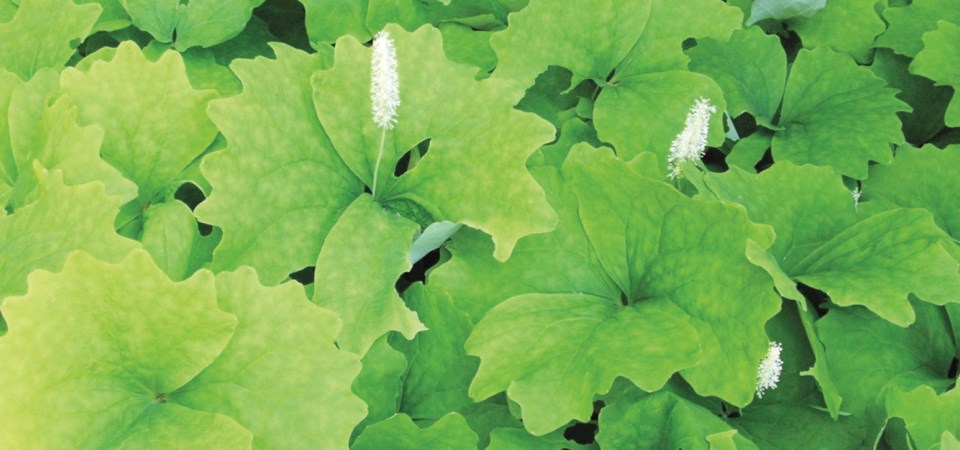Dear Helen: Are there any attractive ground-cover plants that will grow under difficult, hungry-root trees such as cedars?
P.G.
There are. I can personally attest to the stalwart durability and ornamental value of several.
My favourite is epimedium, one of the few plants that thrives impeccably in shaded sites with dry (once the plants are established), root-filled soil. The foliage is beautiful, the tiny columbine-like spring flowers charming. The slow-spreading clumps grow to around 20 cm high.
Epimedium foliage is commonly described as semi-evergreen, but my plantings remain good looking until around mid-February, when I choose to cut the leaf stems to the ground. This is to fully enjoy the early spring display of flowers, which otherwise would be partly hidden by the old foliage. Also, removing the old leaves makes way for a batch of fresh young growth.
Bigroot geranium (Geranium macrorrhizum) is a grow-anywhere plant that, like epimedium, will make a dense and vigorous ground cover even in dry shade. I have fine plantings in both sun and shade. The slightly velvety leaves are scented, the late spring flowers pink. This hardy geranium is a superb weed suppressor. It’s as close to maintenance-free as a plant ever gets.
If you would prefer native plants, consider the low-growing Oregon grape and vanilla leaf. The Oregon grape forms evergreen rosettes of dark green, holly-like toothed leaves and bears showy sprays of yellow flowers in spring. The blue berries that follow are usually picked in August and September and made into jelly, juice or syrup.
This Oregon grape berry crop was plentiful this past summer. My neighbour over the back fence went picking with her partner and shared a jar of delicious jelly with me.
My garden, once native woodland, still harbours both sunny and shaded patches of Oregon grape and of vanilla leaf. The vanilla leaf dies down in winter to emerge in spring in a carpet of long-stemmed, bright green, three-part leaves with unevenly scalloped edges. Late in the spring, slender flower stems arise from the leaf centres, bearing slim spikes of tiny white flowers.
Vanilla leaf, like Oregon grape, spreads on underground stems and is a wonderful carpeter in woodland gardens and for “no-work” edges of a garden. I’m currently letting the plants wander onto my sloping boulevard, an area I don’t wish to expend much energy on.
Also called “sweet after death,” vanilla leaf has traditionally been gathered, dried, and hung in bunches to perfume homes with its sweet vanilla fragrance. The leaves have also been used as an insect repellent.
To give ground-cover plants a decent start in difficult ground underneath trees, remove any low-hanging tree branches to improve air circulation and light exposure. Cultivate or scratch up the soil to the degree possible, and spread some good topsoil or compost before planting. While the plants are becoming established, water enough in dry weather to maintain consistently modest moisture levels. With a spring planting, that means watering through that first summer and until the rains begin in the fall.
Dear Helen: I seeded a larger bed of root vegetables than usual this year and still have carrots in the garden. Do they need to be dug and stored frost-free over the winter? What about beets and parsnips?
B.W.
You can leave all three root vegetables in the garden and harvest them as needed through late fall and winter, as long as they have some sort of protective cover in cold weather. A hard frost can ruin the tops, or “shoulders” of the roots. The cylindrical beets that I grow push themselves well out of the ground. The exposed parts need protection from freezing weather.
When the root vegetable tops die back, the plot can be cleaned and topped with around five cm of soil or around eight cm of leaves. I also keep a sheet of old, used floating row cover over the mulched bed.
Once these lightweight covers develop rips and holes after being used as insect barriers over vulnerable crops, they are still valuable to keep on hand as materials for protecting plants from frost damage. One winter I saved some leafy green vegetables from demolition in an unusually severe cold spell by placing three layers of the lightweight fabric over the plantings.
You are in for a treat There is enormous pleasure in pulling crisp, juicy carrots and beets from a garden plot in winter.



